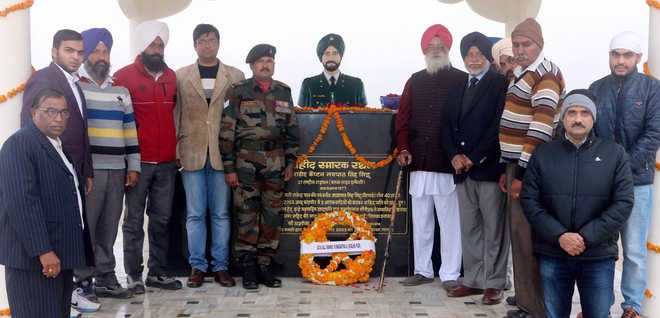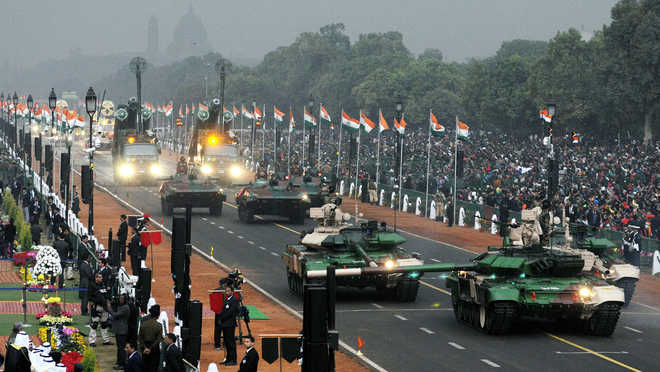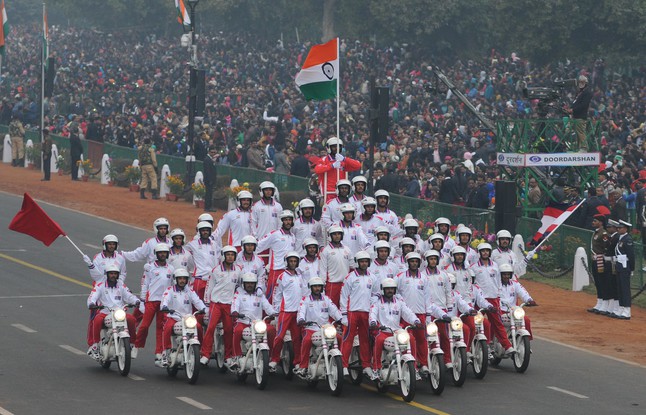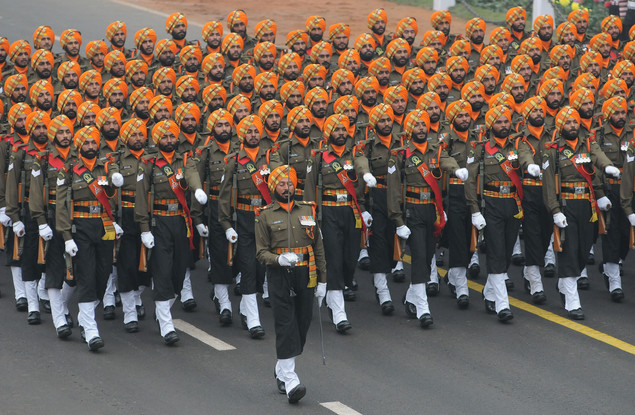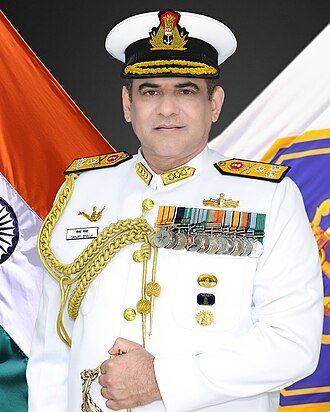Navdeep Singh – Jan 17, 2017, 6:04 am
Snapshot
Perhaps this is an uneasy era, and like all sections of society, the uniformed forces shall also self-adjust with these times.
All stakeholders of the Army must show flexibility and balance to tide over this temporary disquiet.
In my opinion, no organisation, the uniformed services included, is beyond scrutiny.
And with that disclaimer, I would like to emphasise, that the recent events in public gaze concerning our armed forces, triggered by a video posted on social media by a trooper of the Border Security Force (BSF), must not be viewed in black or white, and till the full facts are made known, neither the organisation nor the individual should be the target of preconceived notions or bias.
There is no denying that like other large organisations, the security forces also face certain issues at various levels, but that reality must not become a tool for spreading discontentment, frustration or disaffection or an opportunity to create fissures between the leaders and the led. Scandalising of the subject must cease, but at the same time, such instances, even if assumed as emanating from disgruntled personalities, should lead to all stakeholders trying to ensure resolution and improvement. As I have stated many times in the past, while there is too much focus on anomalies related to pay and pension and other financial matters, real issues which affect the very heart and soul of our organisations comprising brave men and women, are ignored.
Though the incident primarily revolved around bad rations, it has encompassed many facets of life in the uniformed services. Let me comment on certain highlights of various aspects that are being played out in the media and social media. I must warn though that this is going to be a long read.
Us And Them syndrome
All security forces serve the same flag and are expected to work shoulder to shoulder for the same ultimate aim. The episode, however, again brought to fore statements such as “this is the BSF and not the Army” or “this never happens in the Army” or “there is a problem of leadership in the Police Forces” and so on.
That is no consolation. It was the BSF this time, tomorrow it could be the Army.
Irrespective of the veracity of this incident, complaints on quality of ration are not rare in the Army and we must not pretend to be surprised. Further, the Army has had its share of ration (and other) scams too, and the Army is also not a holy entity removed from the society. The quality of roti, kapda and makaan is talked of in hushed tones and we should have the moral courage to admit that and make amends.
While there is no reason for the voices of superiority from military veterans, there is also no reason for former and current members of the Central Armed Police Forces (CAPFs) to play out how they are discriminated against in pay and allowances time and again, especially with regard to the additional Military Service Pay (MSP) granted to defence personnel (Army, Navy and Air Force) but not to those in other uniformed services. It is pertinent to note that there is one inherent difference between the Defence Services and the CAPFs, and that is, while personnel of the former start retiring in their 30s, troopers of the latter retire in their 50s, serving two decades more than the former and in the bargain enjoying not only certainty and protection of livelihood during productive lifetime but also higher lifetime earnings and multiple pay revisions. Similarly, while it is true that the military gets higher allowances in certain field areas, the reverse is also correct wherein CAPFs have an edge. It is a fact that on one hand, over the years, while some of the better military specific allowances stand extended to the other services, the same courtesy or reciprocity has not been allowed to the military. Today, payouts such as the detachment allowance, special duty allowance, tribal area allowance and double house rent allowance are not available to defence services.
Of course, bullets of the enemy do not distinguish between the colour of the uniform and the CAPFs operating in the same area as members of the defence services deserve the same risk-related allowances, but vice versa should also be made applicable. Hence apart from the basic pay, which is broadly the same for all services including the military, there is no comparison of service conditions- you win some, you lose some, and which is absolutely clear at the time of joining service, whether it is the military or the CAPFs.
Yes, discriminatory practices such as inequitable allowances must be ironed out. I am anyway not a believer of superiority or inferiority of any service or organisation. All play a role and all are equal.
Excellent System Of Redressal Of Grievances In The Uniformed Forces?
I tend not to fully agree. The number of representations, petitions, non-statutory complaints, statutory complaints and litigation cannot be termed as low by any stretch of imagination. The redressal of grievances theoretically is apt in the forces, but practically speaking there are many rough edges which need to be smoothened out since handling of grievances is personality oriented and there is no thumb rule. It is argued that the Commanding Officer (CO) is a father figure and if a person does not get redressal from his Commanding Officer, he can always approach the next senior in hierarchy. Easier said than done. Can a prudent person expect a soldier, who has complained against his CO, to have a smooth time thereafter in the unit under that very CO? Are all complaints made to superiors in the hierarchy even promptly forwarded to them? Both answers are in the negative.
Moreover, the CO can only deal with local issues within his control, nothing beyond it, and again, the resolution would be dependent upon personality traits. It is also well known that the formal system of statutory and non-statutory complaints for issues such as confidential reports, disciplinary matters and promotions is a slow grind. While such complaints are supposed to be finalised within six months (against the three months prescribed by civil departments), despite emphasis by successive defence ministers on promptness, complaints are rarely decided in time, unless, let us face it, strings are pulled. What does it lead to? Nothing but frustration and discontentment and lack of closure- aspects that can be easily handled in-house with a well-oiled responsive grievances redressal machinery.
To add to the woes, complaints are rejected on points such as ‘incorrect format’ and what not, leading to more disgruntlement. Should soldiers who are cut-off from the world sitting in tough posts on the border be expected to adhere to formats and red-tape and then wait forever to get their issues resolved? Should soldiers remain preoccupied with their pending grievances or perform their duties? Should a few disgruntled ones then be allowed to disproportionately flag these problems and hurt the image of the entire force? There is hence hollowness on display when we hear phrases of praise for the grievance redressal system. The reality is that one has to be well connected or street-smart to get himself or herself heard and those stating otherwise obviously do not have the courage to admit the follies of the existing system.
Think if you must that we are ‘the best’, but let us strive for making the system even better and ensure objectivity and decisions that are not influenced by any other aspect but the merits of the grievance.
What Can Be Done?
To improve the system of redressal of grievances, some simple steps can be initiated, of course within the four corners of discipline and military efficiency. Steps that would be easy to implement but may not undermine the authority that is needed to command troops into battle.
Going Up The Hierarchy
In case of a grievance related to an individual’s unit or an officer under whom he is serving, rather than jumping the hierarchy, the person must be allowed to write to the higher formations or commanders through proper channel, as is permissible under the existing system, but with an additional concept of a direct ‘advance copy’ to the senior officer as a matter of right. Further, it should be reemphasised strictly that officers in the channel would not hold back any complaint or representation for more than the prescribed days and any such delay would entail a notice to the lower unit, officer or formation from where it was supposed to move up. The authority to who the advance copy is addressed must interact with the affected person and hear him out before reaching a conclusion. Officers should be encouraged not to consider ‘recommendations’ or ‘comments’ from down below as binding and must not shy away from forming own objective opinions by overruling such recommendations, if required.
Opportunity of hearing or interaction:
In case of statutory complaints, which are not routine representations as above, but usually involve career aspects, an opportunity of hearing or interaction must be provided to the complainant by the competent decision-making authority or the authority closest to the decision-making authority. This procedure, recommended recently by a Committee of Experts, of which this author was also a member, already stands accepted by the Defence Minister in principle but the implementation instructions are yet to be issued. Explaining the benefits of such an approach, the following was stated by the Committee:
“…Opportunity of personal hearing or personal interaction has many advantages. It is what is known as sunwai in vernacular. Not only does it lead to satisfaction of the Complainant that he/she has been heard objectively by the decision making authority but at times it may also lead to the competent authority getting convinced that what the Complainant is stating is correct and the picture painted by the authorities on noting sheets lower in the chain could be incorrect. It may be pointed out that in almost all civil organizations and even in the Indian Air Force, opportunity of hearing is freely provided which leads to a higher degree of satisfaction level and also harmony within the system. Though the informal system of ‘interview’ is available in the defence services, it is discretionary and not institutionalized and not at the ‘competent authority level’ especially while dealing with statutory complaints. The system of opportunity of hearing also provides a catharsis to individuals who may feel stifled at times and hence would provide an outlet to at least open up before the competent authority. It becomes all the more important in defence services where there is no trade unionism or associations, and rightly so. It becomes even more important in the stratified rank structure environment and physically long distances of location.
Under the current system, complaints of aggrieved personnel are being dealt with by way of a one-way file noting system on which, after a complaint is submitted, the complainant is neither heard nor is given an opportunity to rebut what is put up against his Complaint by the dealing official chain. At times, decisions are taken based on the comments of those very officers/officials who have been complained against giving rise to a question of bias, which could be simply a perception, or even real, and which may not result in closure of the issue with rampant dissatisfaction due to the very reason that a person has not been heard and only a one-sided decision has been taken. There is also a challenge to address the perception that there remains an element of subjectivity in the processing of the Complaints since the system would perceivably remain favourably inclined towards the organisation. It also so happens that on many occasions, especially at ranks other than Commissioned Officers, personnel are apprehensive in approaching the institutional redressal system for the fear of reprisal from superiors. All this would change with the system of institutionalizing ‘opportunity of hearing’ which would not only be in tune with the best practices of the current times, but also in line with decisions of Constitutional Courts, the views of the Hon’ble Raksha Mantri and also DoPT instructions issued from time to time. In fact, it has been emphasized time and again even by the Department of Administrative Reforms & Public Grievances that employees’ frustration rises from the perception of inaccessibility and lack of concern of superior officers, failure to acknowledge and act upon grievances and non-involvement in organizational activities…”
Faster And Time-Bound Redressal
Timelines on grievances must be strictly adhered to and non-processing in time should provide a right of audience for the soldier to the competent authority. Though there must be a balance between individual and organisational rights, the precious personal rights cannot be held hostage to administrative lethargy. Again, in such cases, when grievances are not decided within a particular time limit, to obliterate any negative usage of other unauthorised channels, soldiers must have a system of informing the competent authority directly or through electronic means, and the designated authority should be obliged to provide an audience or interaction. It is well known that many complaints are rendered infructuous, including in career related issues, due to the fact that they are not decided in time.
I would mince no words in stating that it is truly unfortunate that seven decades after independence we have not been able to even ensure decisions on complaints within laid down time limits, and time limits which, ironically, are themselves needlessly generous- six months in most cases. It should not be forgotten that timely, objective and fair disposal of a grievance is like a legally provided pressure valve which can provide quietus to an issue and bring closure for a person, but if that vent or outlet is not provided, the built-up pressure is bound to escape through routes that would not be palatable.
Social Engineering And Flattening Of Hierarchy Through Technology
The Army Chief’s idea for grievance boxes is a welcome step but it may prove to be ungainly since he alone would not be able to monitor grievances from such a large manpower, and some of such complaints would be frivolous and personal rants which would have to be filtered out. Since interaction with senior officers is not feasible at all times due to the nature of duties, there must be an established system for more interaction in real time with seniors without being put up through staff officers with a hackneyed approach, and for designated grievance officers in all formations who must remain insulated from influence and subjectivity.
This actually is nothing new. The Army’s Western Command under the aegis of the then Army Commander, Lt Gen KJ Singh, had initiated a blog wherein all ranks were free to float suggestions, recommendations and grievances. In fact, it could be loosely termed as an electronic and more feasible version of a grievance box advocated by the Chief of the Army Staff. It provided real-time outlet for such issues thereby eliminating simmering undercurrents. Further, this was not done as a mere formality but grievances and recommendations were acted upon and star recommendations were also publically awarded. At the same time, the same Army Commander had also done away with an eatery in a market within the cantonment which had separate sitting spaces for families based on ranks. While hierarchy within official spaces and establishments cannot be avoided, and in fact may be desirable, public spaces for families in cantonments need to be rendered totally rank-neutral.
The sahayak system is also in news. Though the uniformed services often emphasise the ‘buddy system’ and ‘breaking bread together’ and the ‘camaraderie’, it is still felt in certain quarters that there is a clash of societal dynamics which has resulted in personnel resisting work outside their charter of duties. The system, by whichever name it may be called, is an integral part of operational environment and apart from relieving Commissioned Officers and Junior Commissioned Officers from the rigmarole of mundane day to day issues, sahayaks act as a bridge between the troops and their leaders. Just as support staff is provided to officers to enable them to perform duties efficiently in peace and staff appointments, sahayaks are entitled in units and formations on war establishment. If an officer cannot be expected to type all his letters without assistance of a clerk in a staff appointment, he cannot also be expected to perform routine administrative tasks and run around without assistance in a field appointment.
Rules anyway prohibit combatants from being used for domestic chores, but it does seem that the concept has faltered and has become hazy due to unfortunate aberrations. If there is so much hue and cry on this subject, obviously there must be things that require to be fixed. With some very senior officers and veterans brushing aside the voices raised against the exploitation of the system, we should simply ask ourselves whether the system is being misused or not. Even if the answer is uncomfortable, it should not be ignored, and with changing social dynamics, the effort should be to provide a practical alternative without compromising the dignity of combatants.
Due to frequent movements, military families have to struggle for survival in new places every now and then, they even have to live most of the service life without the breadwinner. It is a nightmare, to say the least. There is hence requirement of support but the answer to that must be brainstormed by the establishment itself. Whether it is staff specially recruited for the purpose, whether it is manpower arranged out of contributory funds at each station centrally after due verification or whether it is a trained and organised system of housekeepers and maids with background checks at military stations paid by those who employ them – it is for the stakeholders to devise and find a solution to. In fact, the few cases of transgression cannot be blamed upon the uniformed organisations per se or even on officers, we have simply failed to provide an alternative, and in other cases, it might be a sense of entitlement at play and being miserly with a tendency to live on the house, crudely put. Yes, the issue is blown out of proportion every now and then with extreme stands on both sides, yet, a long lasting solution needs to be found.
Stress And Strain Of Military Service And Its Effect On Mental Health
At times, there is a thin line between misdemeanour and a psychiatric condition, a line which is not discernable to an untrained eye. Stress and strain is the hallmark of military service, which is recognised universally, all over the world. The fact that a person is away from his family most of the year and cannot hence fulfil domestic commitments results in added pressure which at times becomes unbearable. It is not a sign of weakness, we’re all different and the body reacts differently to varied stimuli. Under such pressures, certain individuals tend to develop conditions which need care and sensitivity and not disdain. For example, a person may wander out of the lines due to his mental condition and while a mature leader of troops may rightly refer him to a psychiatrist, another may simply declare him absent without leave. Similarly, mature leaders would understand that while intoxication on duty could be an offence, alcoholism could well be a psychiatric condition. While I do not mean to defend the BSF trooper we all saw on TV, I found it a little odd for him to be summarily branded as a ‘bad hat’ or an ‘alcoholic’. If so, he required psychiatric care and not entrustment with a weapon in an operational area! Officers should not forget that stress and strain of service and effect on mental health is much higher on lower ranks than on higher ranks.
A great contributor is the inability to cope up with requirements back home, seemingly small little matters- education of children, property disputes, registration of house, municipal work and so on, and an insensitive administration does not help. While officers are still able to get a grip by speaking to their civilian counterparts and are blessed with better education and wherewithal, personnel of lower ranks are at sea, the result of which is stress which is then also wrongly blamed on ‘domestic reasons’ while the actual cause is military service and its exigencies which keep troops away from efficient and timely resolution of the multitude of issues back home, but that is another story for another time.
The times we live in are complicated and there are no easy solutions. The answers, or even the questions, cannot be so simplistic as many of us seem to believe. There is no wrong and no perfect right, there is no black and there is no white. The only truth in this is the fact that this perhaps is an uneasy era, but just like the society, the uniformed forces shall also self-adjust with these times. The churning is not comfortable but all stakeholders must show flexibility and balance to tide over this temporary disquiet.
Navdeep Singh
Major Navdeep Singh is a practising High Court lawyer, author and the founding President of the Armed Forces Tribunal Bar Association. He is Member of the International Society for Military Law and the Law of War at Brussels.
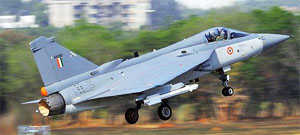













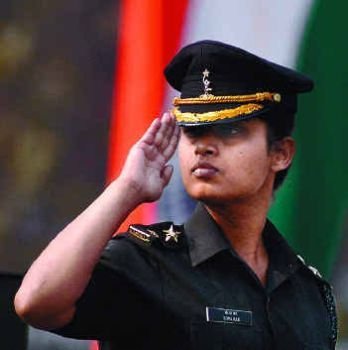

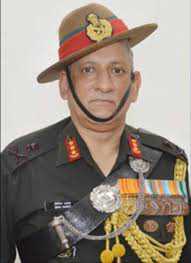

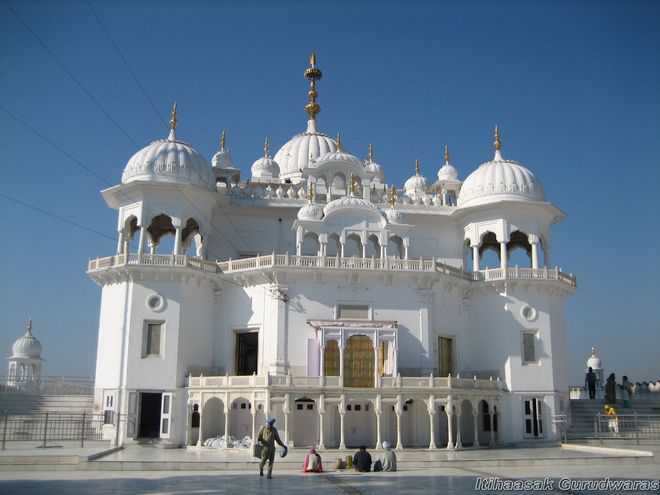

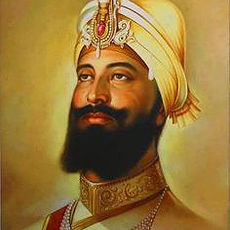






.jpg)

.jpg)

